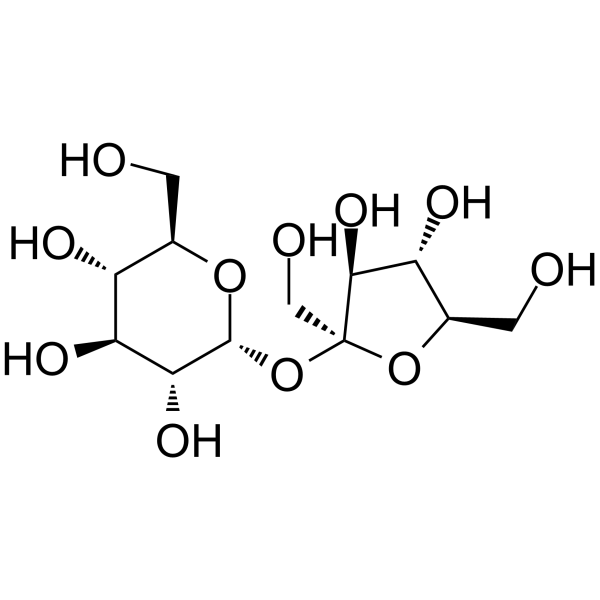天然产物 糖类和糖苷 Saccharides and Glycosides
Sucrose;(Synonyms: 蔗糖; D-(+)-Saccharose) 纯度: ge;98.0%
Sucrose (D-(+)-Saccharose) 是一种二糖,由葡萄糖和果糖两种单糖组成。Sucrose 可应用于一些动物模型,包括代谢性疾病、肥胖、偏食、糖尿病等。

Sucrose Chemical Structure
CAS No. : 57-50-1
| 规格 | 价格 | 是否有货 | 数量 |
|---|---|---|---|
| Free Sample (0.1-0.5 mg) | ; | Apply now | ; |
| 100 mg | ¥500 | In-stock | |
| 200 mg | ; | 询价 | ; |
| 500 mg | ; | 询价 | ; |
* Please select Quantity before adding items.
Sucrose 相关产品
bull;相关化合物库:
- Natural Product Library Plus
- Drug Repurposing Compound Library Plus
- FDA-Approved Drug Library Plus
- FDA-Approved Drug Library Mini
- Bioactive Compound Library Plus
| 生物活性 |
Sucrose (D-(+)-Saccharose) is a disaccharide which is composed of two monosaccharides, glucose and fructose. Sucrose can be applied in some animal models, including metabolic disease, obesity, diet on preference, and diabetes, et al[1]. |
||||||||||||||||
|---|---|---|---|---|---|---|---|---|---|---|---|---|---|---|---|---|---|
| IC50 Target |
|
||||||||||||||||
| 体内研究 (In Vivo) |
Sucrose is a disaccharide which is composed of two monosaccharides, glucose and fructose. Compare to chow-feeding, high-energy (HE)-feeding results in an overall decreased preference for Sucrose solutions in both strains. Specifically, obesity-prone (OP) rats prefer 0.3 M and 1.0 M Sucrose solutions less during HE-feeding relative to chow-feeding (P=0.046 and P=0.012, respectively). As well, obesity-resistant (OR) rats exhibit decreased preferences for 0.01 M, 0.03 M, and 1.0 M Sucrose when HE-fed compare to chow-fed counterparts (P<0.0001, P=0.043, and P=0.013, respectively). Chow-fed OP rats consume significantly less of 0.03 and 0.1 M Sucrose solutions relative to OR animals (P<0.0001, for both) while HE-fed OP rats consume less of a 0.1 M Sucrose solution only (P<0.05), compare to HE-fed OR rats[1]. MCE has not independently confirmed the accuracy of these methods. They are for reference only. |
||||||||||||||||
| Clinical Trial |
|
||||||||||||||||
| 分子量 |
342.30 |
||||||||||||||||
| Formula |
C12H22O11 |
||||||||||||||||
| CAS 号 |
57-50-1 |
||||||||||||||||
| 中文名称 |
蔗糖 |
||||||||||||||||
| 运输条件 |
Room temperature in continental US; may vary elsewhere. |
||||||||||||||||
| 储存方式 |
|
||||||||||||||||
| 溶解性数据 |
In Vitro:;
H2O : 100 mg/mL (292.14 mM; Need ultrasonic and warming) DMSO : 100 mg/mL (292.14 mM; Need ultrasonic) 配制储备液
*
请根据产品在不同溶剂中的溶解度选择合适的溶剂配制储备液;一旦配成溶液,请分装保存,避免反复冻融造成的产品失效。 In Vivo:
请根据您的实验动物和给药方式选择适当的溶解方案。以下溶解方案都请先按照 In Vitro 方式配制澄清的储备液,再依次添加助溶剂: ——为保证实验结果的可靠性,澄清的储备液可以根据储存条件,适当保存;体内实验的工作液,建议您现用现配,当天使用; 以下溶剂前显示的百
|
||||||||||||||||
| 参考文献 |
|
| Animal Administration [1] |
A total of 66 male 8-wk-old Sprague-Dawley obesity-prone (OP) and obesity-resistant (OR) rats (n = 38 per each phenotype), weighing 275 g and 210 g respectively, are used in this study. After recovery and attaining pre-surgical weights, rats undergo three training trials of 60-min sham feeding sessions with 0.03 M Sucrose solution. During testing, rats are briefly deprived of water (0900 to 1600 h) but not food, and are tested for 1 h (1400 to1500 h) sham intake of 0.03 M Sucrose solution until a stable baseline is achieved. Afterwards, rats are sham fed one of three Sucrose solutions (0.03, 0.3, and 1.0 M) in random order, every other day, with each concentration tested at least twice. Sucrose intake is individually recorded every 5 min for 60 min[1]. MCE has not independently confirmed the accuracy of these methods. They are for reference only. |
|---|---|
| 参考文献 |
|
